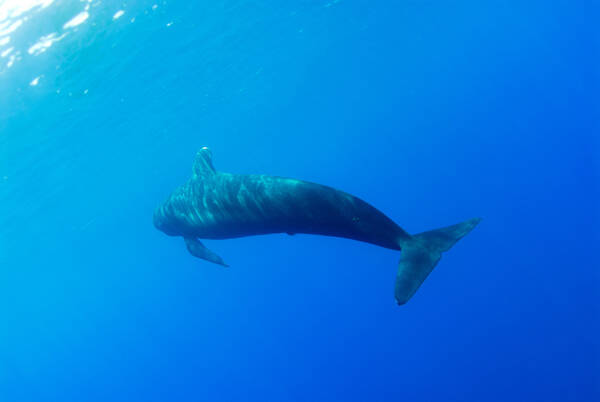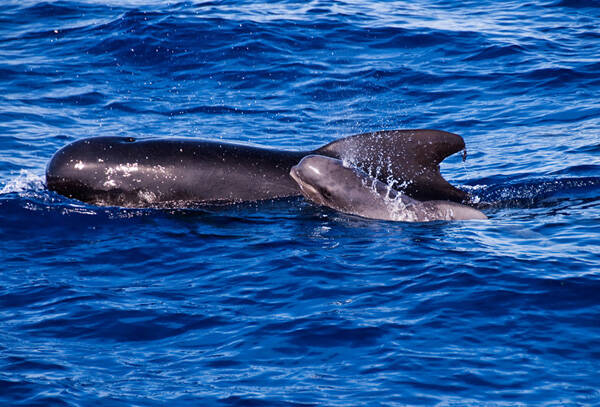Globicephala melas
IUCN
LCBasic Information
Scientific classification
- name:Globicephala melas
- Scientific Name:Atlantic pilot whale, black whale, pilot whale
- Outline:Cetacea
- Family:Delphinidae p.whale
Vital signs
- length:4.8-6m
- Weight:About 1800kg
- lifetime:46-59
Feature
Its forehead is round and its dorsal fin is sickle-shaped. Its flippers are very long, accounting for 15-20% of its body length.
Distribution and Habitat
Distributed intermittently in the temperate and near-polar regions of the northern and southern hemispheres.
Main distribution countries and regions: including Algeria, Argentina, Australia, Belgium, Bouvet Island, Brazil, Canada, Chile, Denmark, Falkland Islands, Faroe Islands, France, Germany, Greenland, Iceland, Ireland, Isle of Man, Italy, Libya, Malta, Mauritania, Morocco, Namibia, Netherlands, New Zealand, Norway, Peru, Portugal, Azores (Portuguese island), Saint Pierre and Miquelon (French island), South Africa, South Georgia Island, South Sandwich Islands, Spain, Sweden, Tunisia, United Kingdom, United States, Uruguay, Western Sahara, etc.
Appearance
The most typical feature of the long-finned pilot whale is its large, rounded head. In contrast, the beak is not obvious or negligible. The base of the dorsal fin is long and wide, extending forward in a sickle shape. The flippers are slender and the tail accounts for 15-20% of the body length. The body is mostly black, with a light gray saddle-shaped patch on the dorsal fin; a gray line extends from the middle of the abdomen to the front section, forming an anchor-shaped band. Males are 6 meters long, the longest is 8.5 meters, and weigh about 3,800 kilograms. Females are slightly smaller, up to 6 meters, 4.8 meters long on average, and weigh about 1,800 kilograms. Newborn whales do not have a bulge on their heads until they grow up.
Details
Long-finned pilot whale (scientific name: Globicephala melas) is also known as Atlantic pilot whale and black round-headed whale. There are two subspecies.

Long-finned pilot whales are a group of organisms that like to live in cold salt water areas with a temperature of 13-30℃. The diving depth is 30-1800 meters, with huge changes. Generally, it only moves in the water layer of 30-60 meters. It can dive for several minutes and dive for more than 10 minutes for feeding.
Long-finned pilot whales are highly gregarious. A group of whales called "pods" (a term for groups of dolphins, seals or whales) usually consists of 10-50 individuals, and as many as more than 1,000 individuals. This type of whale group is very social and sometimes communicates with bottlenose dolphins and gray dolphins. There are both males and females in the "pod". Related female whales prefer to form a tight pod group, while male whales constantly change groups. Due to the relatively high mortality and departure rate of males, the proportion of females in the whale group is higher. The entire "pod" group participates in snorkeling and tail slapping activities. Some individuals will swim to the beach, and due to the strong family concept of the whale group, they will sometimes be stranded on the beach together.

Long-finned pilot whales are carnivorous animals, mainly feeding on mollusks and fish, eating about 34 kilograms of food a day. They like squid the most, followed by mackerel, Atlantic herring, cod, and halibut. It is reported that long-finned pilot whales use the group effect advantage of human fishing to form a fast predation ability. Research has found that long-finned pilot whales can live both in the open ocean and along the coast. Females live longer than males, up to 59 years, while males live up to 46 years.
The mating season of long-finned pilot whales runs throughout the year, with the peak in late spring and early summer from April to June, when males compete with each other for mating with females. Female whales reach sexual maturity at the age of 6, while male whales take longer, reaching maturity at around 12 years old. Female whales are pregnant for 16 months to give birth to offspring, and the interval between mating and breeding is four years. Newborn whales weigh about 100 kilograms and are 1.8 meters long. Female whales are responsible for taking care of their calves, and the lactation period is 23 to 27 months. Female whales can still give birth at the age of 35, and can still breastfeed at the age of 51, so they can take care of their calves until they grow up to 10 years old. Although the reproductive period covers the whole year, most calves are born in the summer.

There is not enough information on the global dynamics of the long-finned pilot whale population, and even less on its subpopulations. Surveys in 1987 and 1989 estimated that there are more than 750,000 long-finned pilot whales in the central and northeastern North Atlantic. About 200,000 long-finned pilot whales gather in the southern Antarctic for the summer each year. There are about 31,139 pilot whales living in the western North Atlantic (a few short-finned pilot whales are also counted).
On June 16, 2017, locals in the Faroe Islands, a former Danish colony in Northern Europe, collectively killed a large number of pilot whales on the beach, and the sea water was "dyed" red. According to statistics, the Faroe Islands kill more than 950 pilot whales each year, producing more than 500 tons of whale meat and blubber.
Listed in Appendix II of the Convention on the Conservation of Migratory Species of Wild Animals (CMS).
Listed in Appendix II of the Convention on International Trade in Endangered Species of Wild Fauna and Flora (CITES).
Listed in the 2008 Red List of Threatened Species of the World Conservation Union (IUCN) ver 3.1 - Data Deficient (DD).
Protect wild animals and eliminate game.
Maintaining ecological balance is everyone's responsibility!








